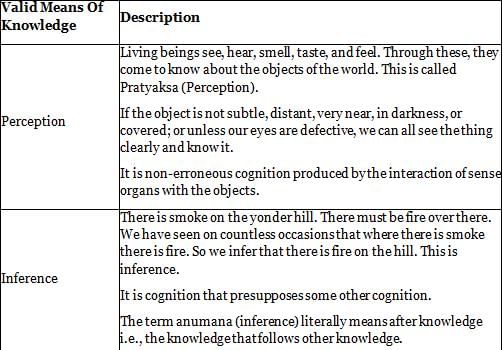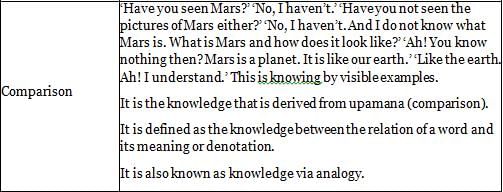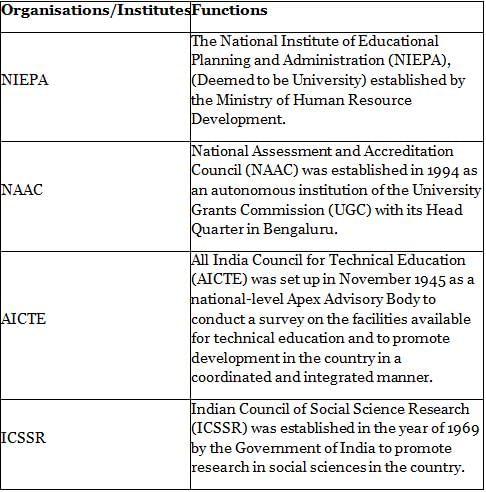APSET Paper 1 Mock Test - 4 - AP TET MCQ
30 Questions MCQ Test - APSET Paper 1 Mock Test - 4
A lecture without feedback from the students is ______.
Directions: In making decisions about an important question, it is desirable to be able to distinguish between 'strong' arguments and 'weak' arguments. 'Strong' arguments are those which are both important and directly related to the question. 'Weak' arguments are those which are of minor importance and also may not be directly related to the question or may be related to a trivial aspect of the question.
The given question is followed by arguments numbered I and II. You have to decide which of the arguments is/are 'strong' argument(s) and which is/are 'weak' argument(s) and mark your answer accordingly.
Q. Should there be a silver bullet solution for the 'Kashmir problem'?
Arguments:
I. No, there is not just one Kashmir problem in the country, but many, and each requires redressal by divergent means and at different stages.
II. No, there is a set of disparate problems of governance and of a communal, polarising and disruptive politics, each demanding a separate solution.
The given question is followed by arguments numbered I and II. You have to decide which of the arguments is/are 'strong' argument(s) and which is/are 'weak' argument(s) and mark your answer accordingly.
Arguments:
I. No, there is not just one Kashmir problem in the country, but many, and each requires redressal by divergent means and at different stages.
II. No, there is a set of disparate problems of governance and of a communal, polarising and disruptive politics, each demanding a separate solution.
Which of the following are the fundamental duties of a citizen?
- Respect for the Constitution, the National Flag and the National Anthem
- To develop a scientific temper
- Respect for the Government
- To protect wildlife
Direction: Read the given passage and answer the questions that follow.
Early feminist theory had emphasised the commonalities of women's oppression, neglecting profound differences between women in terms of class, age, religion, race and nation. As its exclusionary nature became evident, the collective 'we' of feminism was called into question. The inadequacies of feminist theorising that conflated the condition of white, middle class women with the condition of all women were highlighted in North America by black and Latin feminists, and in Britain by black and Asian feminists. Such critiques evoked the concepts of 'inter‐locking identities' and inter‐locking oppressions'. Related and more radical analyses came from feminist scholars in the Third world, where quite different agendas were called for. These critiques heightened the irrelevance of western feminism's analytical frameworks to the lives of most women around the world and attempted to reposition feminist debate within broader social, economic and cultural contexts of analysis advocated by scholars such as Janus. Such critiques spoke from a post‐colonial position, in which the self‐assumed authority of western feminists to speak about or indeed for others was disputed and decentered. Influential accounts of the tendencies of masculinist imperialist ideological formation to construct a 'monolithic Third world' woman', discursively constituted as the universal victim of Third world patriarchy, challenged feminists to "unlearn" their privilege and to deconstruct their own authority as intellectuals. These positions appeared to question the legitimacy of outside intervention of any kind, whether intellectual or political. Although subsequently attempted by the Third world scholars anxious to move beyond standpoints that threatened to mark all feminist politics as either inauthentic or unnecessary, they were enduringly influential in highlighting the questions identity and authority in feminist studies.
Q. The passage speaks of:
Directions: Read the following passage carefully and answer the question.
I had occasion to work with her closely during the Women's International Year in 1975 when she was chairing a Steering Committee and made me the member in charge of publicity. Representatives from different political parties and women's organisations were on the committee, and though the leftists claimed a sort of proprietary right over her, Aruna encouraged and treated all members alike. It was not her political affiliations or her involvement in a particular cause, which won her respect and recognition, but her utter honesty in public life, her integrity and her compassion for the oppressed which made her an adorable person. She had the courage to differ with and defy the mightiest in the land; yet her human spirit prompted her to work in the worst of slums to offer succour to the poor and the exploited.
In later years – around late eighties and early nineties – Aruna Asaf Ali's health began to deteriorate. Though her mind remained alert, she could not actively take up her pet causes – action for women's advancement, planning for economic justice, role of media, reaffirmation of values in public affairs etc. Slowly, her movements were restricted and Aruna, who had drawn sustenance from common people, from her involvement in public life, became a lonely person. She passed away in July 1996.
Q. Who tried to monopolise Aruna as their proprietary right?
Educational technology that has its origin in physical science and engineering:
a. Educational technology I
b. Educational Technology II
c. Hard approach
d. Soft approach
Select the correct answer from the code given below:
Direction: Read the information carefully and answer the following question.
For a country, CO2 emission (million metric tons) from various sectors are given in the following table.
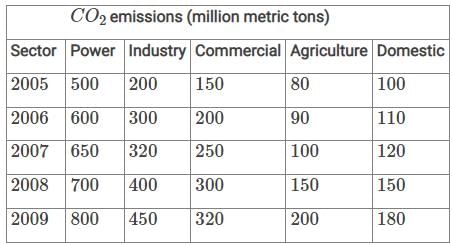
Q. By what percentage (\%\), the total emissions of CO2 have increased from 2005 to 2009?
List I mentions the four valid means of knowledge as given by gotama while List II gives their description. Match List-I with List-II:
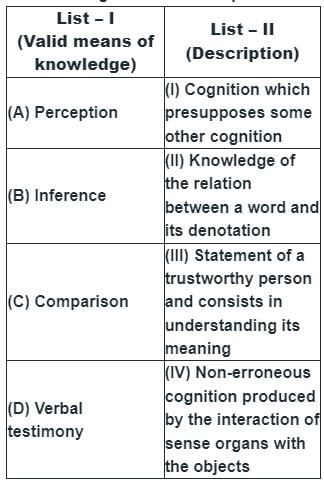
Choose the correct answer from the options given below:
Which of the following initiatives has been implemented by MHRD under NMEICT Programme to incorporate Robotics into engineering education with the main objective of providing hands on application of Computer science, mathematics and engineering principles?
Which of the following factor(s) affect the process of teaching?
(i) Experience of a teacher
(ii) Subject matter of teaching
(iii) Classroom environment
(iv) Human relation skill
If the statement 'most of the students are obedient' is taken to be true, which of the following pairs of statements can be claimed to be true?
I. All obedient persons are students.
II. All students are obedient.
III. Some students are obedient.
IV. Some students are not disobedient.
Which of the following is an example of proprietary system software?
Match List I with List II

Choose the correct answer from the options given below:
System software is the set of programs that enables the computer’s hardware devices and _________ software to work together.
Direction: Read the passage given below and answer the questions by choosing the correct/most appropriate options.
More than eight months after the national lockdown was announced in late March, urban India is learning to live with the Covid-I9 pandemic. In fact, indicating a positive outlook for the future, many survey respondents in a recent survey say they plan to return to pre-lockdown levels of shopping, personal grooming, going to cinemas and socializing as pandemic fears continue to recede.
The survey findings highlight that the suppression of consumer demand because of fears of job losses and salary cuts could be coming to an end. Increasingly, urban Indians are showing increased confidence about the future of the economy. This could be an indicator of the possible 'pent-up demand' that several economists have been talking about — a demand that could be unleashed once a vaccine is developed and distributed, or when there are signs of the pandemic's spread reducing to negligible levels or vanishing totally.
Around 65 per cent of respondents said they had settled into new routines, or that they saw signs of the situation improving, or they had come to terms with the pandemic and were moving on with their lives. And since the survey was conducted before the news of the successful trials of the Pfizer vaccine for the coronavirus was announced, it is likely that the consumers are now even more positive in their outlook about the future.
Q. Which statement in the passage/phrase indicates that 'Life must go on'?
Which one of the following is a good psychological factor for effective learning to take place?
Direction: Read the passage carefully and answer the following question.
If the world is different today, we need to think, talk and engage accordingly. Falling back is unlikely to help, he said adding “purposeful pursuit of national interest is shifting global dynamics”. Highlighting India’s new approach in dealing with terrorism he compared “lack of response to the terror attack in Mumbai in comparison to the way the country responded to the Uri and Pulwama strikes. On India walking away from the Regional Comprehensive Economic Partnership, the external affair minister said no agreement was better than having a bad agreement.
Giving a historical perspective to geopolitical issues, Jai-Shankar said “For years India’s position on the world state seemed assured but the 1962 conflict with China significantly damaged India’s standing.
Q.“For years India’s position on the world state seemed assured but the 1962 conflict with China significantly damaged India’s standing."
The above statement was given by:
Directions: The question is based on the following table.
DEMAND FOR GAS (Million Cubic meters/day)
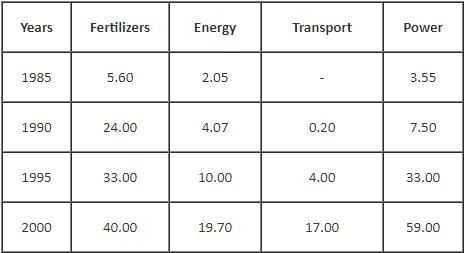
Q. From 1985 to 2000, which is the sector that has been experiencing roughly double the demand every five years?
Directions: In making decisions about an important question, it is desirable to be able to distinguish between 'strong' arguments and 'weak' arguments. 'Strong' arguments are those which are both important and directly related to the question. 'Weak' arguments are those which are of minor importance and also may not be directly related to the question or may be related to a trivial aspect of the question.
The given question is followed by arguments numbered I and II. You have to decide which of the arguments is/are 'strong' argument(s) and which is/are 'weak' argument(s) and mark your answer accordingly.
Should Indian government invest more time and resources to collect data, on the basis of which GDP (Gross Domestic Product) is calculated?
Arguments:
I. Yes, there is no good way yet to collect data from the hundreds of millions of establishments that constitute the production sector of our economy.
II. No, it would just take too long and cost too much, especially since much of the production sector of our economy keeps no records.
Direction: Select the option that is related to the third word in the same way as the second word is related to the first word.
Biology : Science : : Political Science : ?
Direction: Read the following passage carefully and answer the question.
If India has to develop her internal strengths, the nation has to focus on the technological imperatives, keeping in mind three dynamic dimensions: the people, the overall economy and the strategic interests. These technological imperatives also take into account a ‘fourth’ dimension, time, an offshoot of modern-day dynamism in business, trade, and technology that leads to continually shifting targets. We believe that technological strengths are especially crucial in dealing with this fourth dimension underlying continuous change in the aspirations of the people, the economy in the global context, and the strategic interests. The progress of technology lies at the heart of human history. Technological strengths are the key to creating more productive employment in an increasingly competitive market place and to continually upgrade human skills. Without a pervasive use of technologies, we cannot achieve the overall development of our people in the years to come. The direct linkages of technology to the nation’s strategic strengths are becoming more and more clear, especially since the 1990s. India’s own strength in a number of core areas still puts it in a position of reasonable strength in the geopolitical context. Any nation aspiring to become a developed one needs to have strengths in various strategic technologies and also the ability to continually upgrade them through its own creative strengths. For people-oriented actions as well, whether for the creation of large scale productive employment or for ensuring nutritional and health security for people or for better living conditions, technology is the only vital input. The absence of greater technological impetus could lead to lower productivity and wastage of precious natural resources. Activities with low productivity or low-value addition, in the final analysis, hurt the poorest most. The technological imperatives to lift our people to a new life, and to life, they are entitled to be important. India, aspiring to become a major economic power in terms of trade and increase in GDP, cannot succeed on the strength of turnkey projects designed and built abroad or only through large-scale imports of plant machinery, equipment and know-how. Even while being alive to the short-term realities, medium and long-term strategies to develop core technological strengths within our industry are vital for envisioning a developed India.
Q. More productive employment demands :
Which one of the following schools has not accepted anumana (inference) as a valid source of knowledge?
Which of the following set of statements reflects the basic characteristics of teaching?
(A) Teaching is related to learning.
(B) Teaching is a ‘task’ word while learning is an ‘achievement’ word.
(C) One may teach without learning taking place.
Direction: Study the following table chart carefully and answer the question given beside.
The following table represents the Maximum marks of five subjects and marks obtained by five students in five subjects.
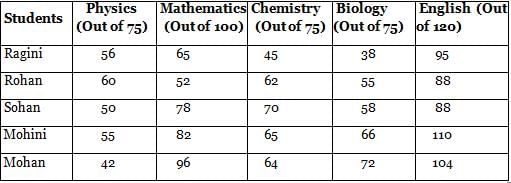
Q. Find the respective ratio of the marks obtained by all the students in Mathematics and marks obtained by all the students in Chemistry.
If the salary of a person was first increased by 10% and later, the same was reduced by 10%, then the net change in his salary is
Which of the following statements is true in respect of computers?
Which of the following have the potential to trigger a tsunami?
1. Landslides
2. Volcanic eruptions
3. Glacial calving
4. Meteorite impact
Organisational communication can also be equated with








